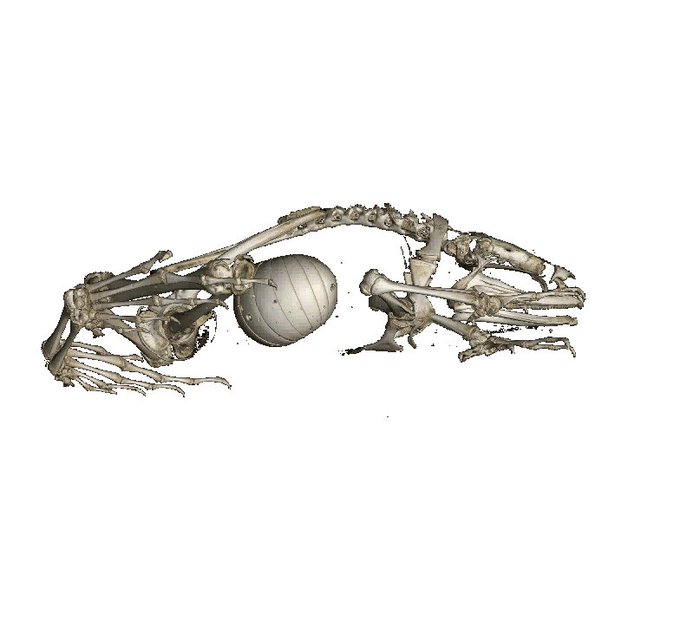holotypeのTwitterイラスト検索結果。 59 件中 3ページ目
Public Service Announcement: I've got a new article out on the history of the @MuseumofNature's Daspletosaurus holotype in this month's Prehistoric Times magazine. #CMNPalaeo
#SundayFishSketch of Masterpisces, though it looks a little like Dunkleosteus, is the oldest known vertebrate to give birth to live young. The holotype was found in 2005 in the Gogo Formation in Australia.
Paranthropus aethiopicus is one of the fossil #hominin species that may be a "nomen dubium". The holotype specimen is Omo 18-18, a jaw that lacks any tooth crowns. What remains isn't distinct from large samples of P. boisei or P. robustus. #paleoanthropology
Many of the most important fossils of human relatives are distorted or fragmented. TM 1517 is the holotype of Paranthropus robustus, found in 1938. Here I've done a reconstruction by mirror-imaging the parts that survived fossilization and erosion. #paleoanthropology #hominin
#FossilFriday The Holotype of Hyolithes baconi from the Ordovician Trenton Fm. in Rock County, WI. Hyolitha is a particularly enigmatic group, but was recently classified as a lophophorate, making it closely related to brachiopods. Type Collection @ucmpberkeley
@skeletaldrawing The new skeletal looks sweet! Ichthyovenator's tail shape would make a lot more sense with this interpretation, though its holotype still lacks many caudals so even that's not certain at the moment. I wonder how extensive the "paddle" might have been compared to Spinosaurus...
Fun fact, I actually redid a whole new Procompsognathus for the article, but ended up going with the old one anyway 'cause I liked how I snuck in the articulated hindlimb from the holotype. https://t.co/72vMa9sMy9
New online: Trotteyn & Ezcurra – Redescription of the holotype of Chanaresuchus bonapartei Romer, 1971 (Archosauriformes: Proterochampsidae) from the Upper Triassic rocks of the Chañares Formation of north-western Argentina https://t.co/CWbcPHTc2r
June 12, 1870, birthday of German paleontologist Ernst Stromer von Reichenbach. Famous for the discovery of the holotype of Spinosaurus aegyptiacus
🦖https://t.co/WS6p1E61aH
🖌 https://t.co/lwAEnPuCZJ
#FossilFriday 🇧🇴This tiny interathere #notoungulate jaw from #Bolivia is now the holotype of a #newspecies, Juchuysillu ("small hoof" in Quechua) arenalesensis (the fossil site). Reconstruction by @VelizarSim w. a mesothere notoungulate behind it. Published in @ameghiniana
For #FossilFriday (and to coincide with the 10th anniversary of @MuseumofNature's VMMB re-opening), here's the holotype foot of the ornithomimid #dinosaur Struthiomimus altus from the CMN collections, alongside images from Lambe's 1902 description of the specimen.
The holotype of Ornitholestes is mounted in such as a way so it looks like the two of you have just met to negotiate business-y things and it's offering a firm handshake.
We found one in the stomach of Rhombophryne vaventy when we micro-CT scanned the holotype :) https://t.co/ZWwCQ0R1RB
T. rex holotype WIP skeletal reference by Franoys
The holotype of the primitive hadrosaurid (Eotrachodon orientalis) from the Santonian of Montgomery Co., AL.
#FossilFriday #Paleontology #Alabama
June 12, 1870, birthday of German paleontologist Ernst Stromer von Reichenbach. Famous for the discovery of the holotype of Spinosaurus aegyptiacus 🦖 https://t.co/WS6p1E61aH 🦖🖌 https://t.co/lwAEnPuCZJ
Here is a (transparent) rotational gif of the skeleton of the holotype of Rhombophryne vaventy, the first species I ever described, with Zoosphaerium sp. in its gut. I just added this to @WikiCommons as CC-BY-SA 4.0 and to https://t.co/Cohb0Ivo68
#microCT #µCT #osteology #Science
#RSOS authors @Val_Fisch et al. are investigating the evolutionary history of polycotylid plesiosaurians through the reinterpretation of the holotype specimen of Thililua longicollis, and clarify its cranial anatomy #FossilFriday https://t.co/v8pjNZQXKx
Composite skeletal reconstruction of Saurophaganax maximus based on holotype and paratype.
Scale bar is 1m.
















































